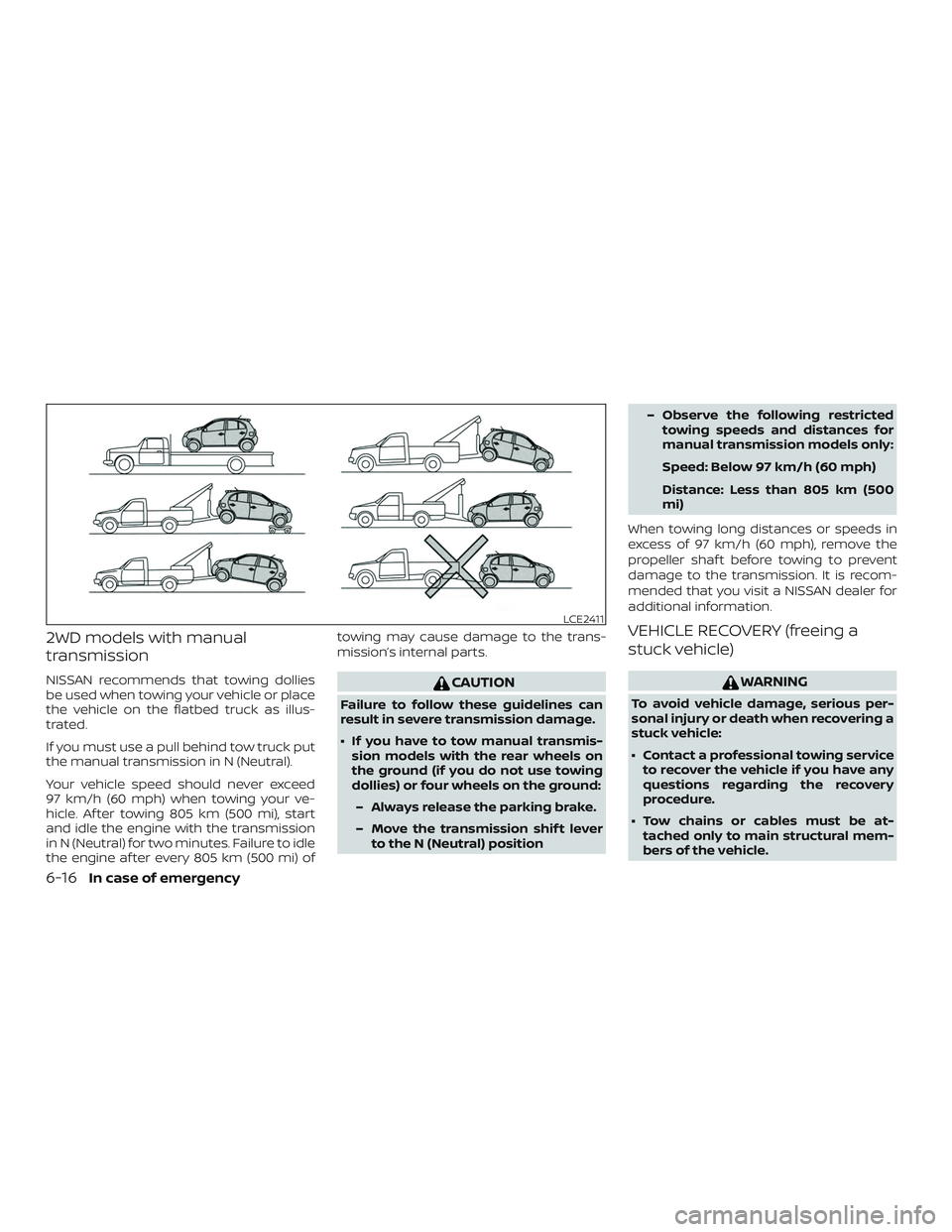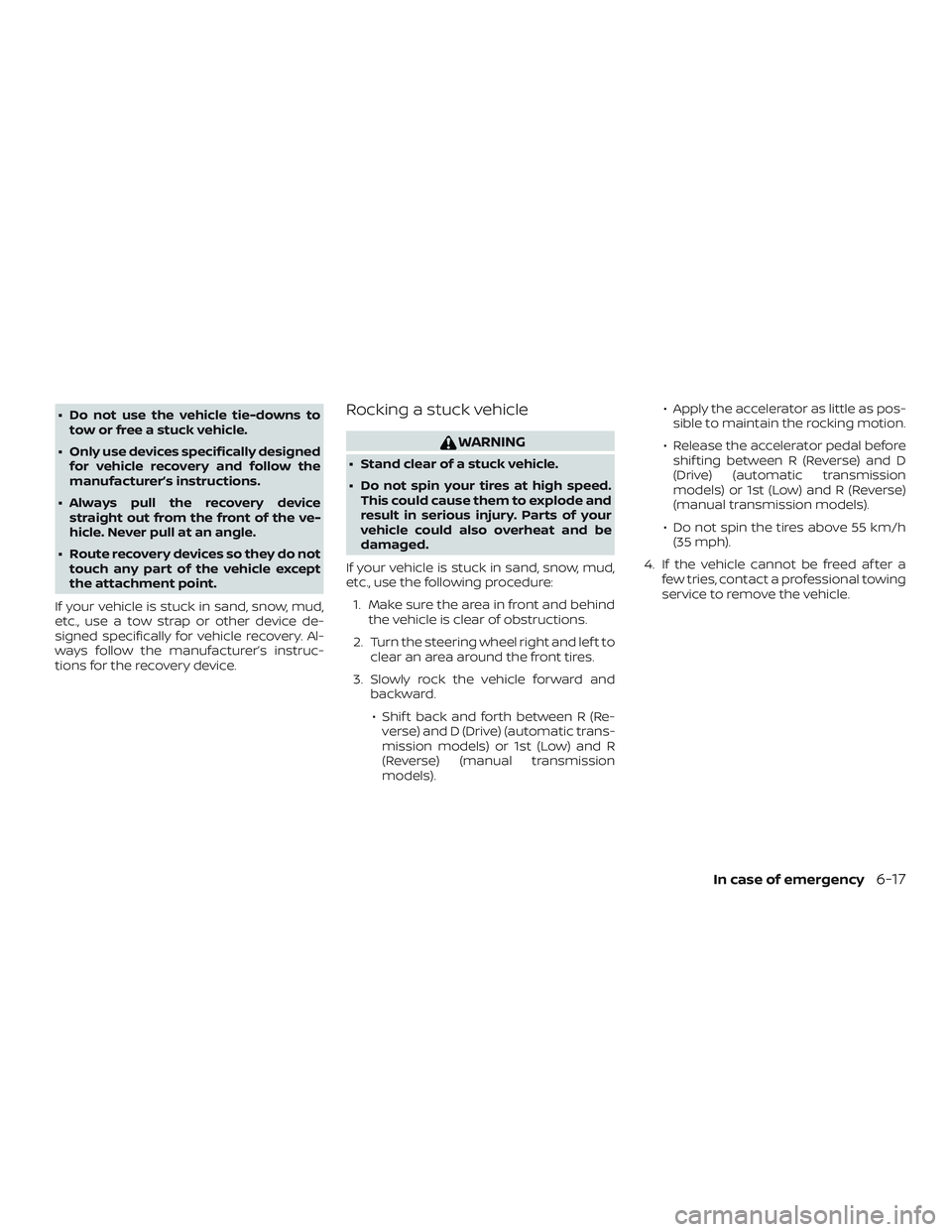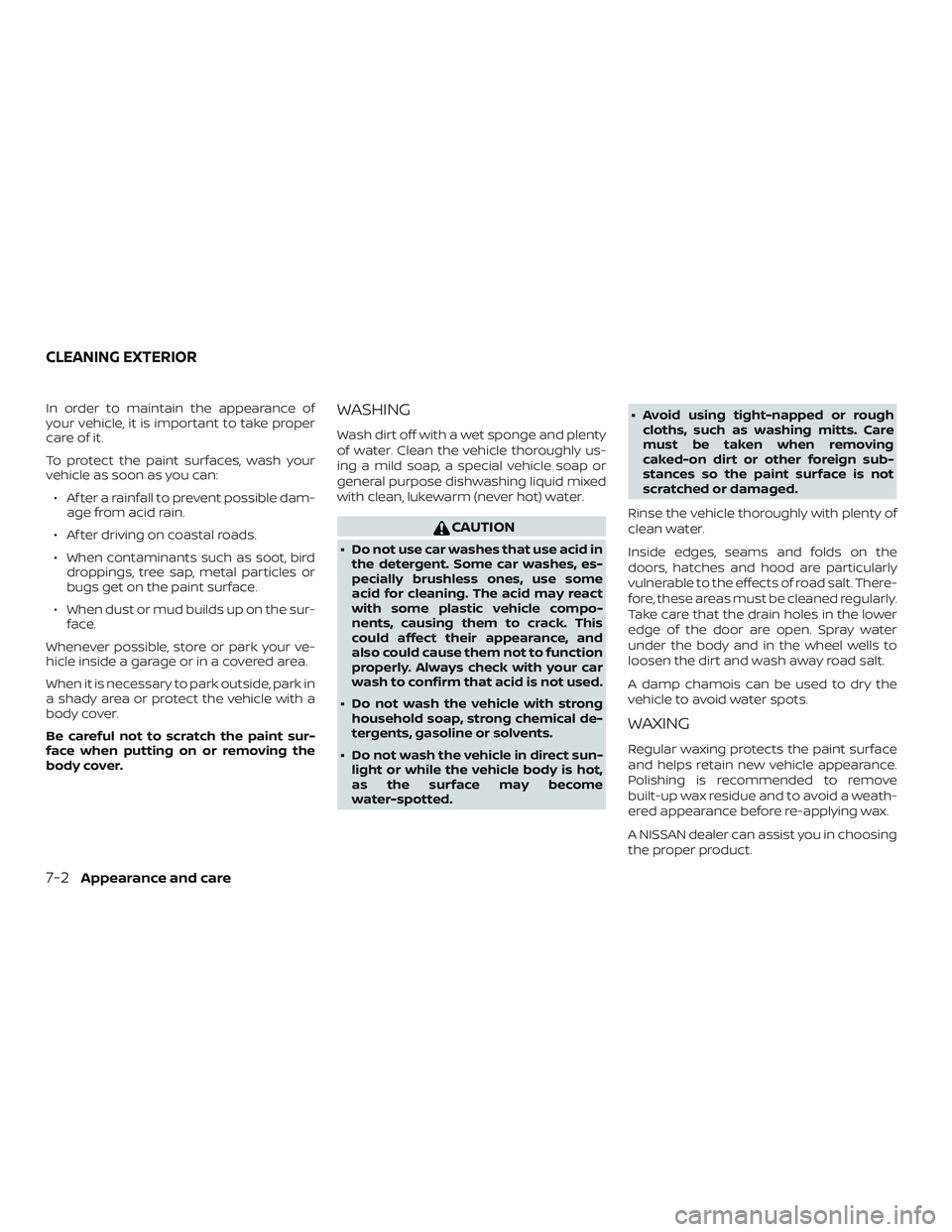Page 223 of 330
1. Open the rear hatch.
2. Remove the luggage floor.
3. Loosen bolt
�1counterclockwise ap-
proximately 20 turns using the wheel
nut wrench and wrench extension to
lower the tire basket.
4. Stop turning the bolt when the tire bas- ket is lowered to a place where it can be
removed from the hook. Do not loosen
the bolt excessively, otherwise the
basket may fall suddenly. 5. Hold the tire basket and remove it from
the hook by pushing the basket
�2up-
ward and moving the hook
�3to re-
lease the basket. 6. Lower the tire basket slowly to the
ground and then put in the temporary
spare tire�4.
LCE2125LCE2097LCE2098
6-8In case of emergency
Page 224 of 330
7. Reinstall the tire basket by pushing up-ward on the basket
�5and inserting the
hook
�6. Please be sure that the hook is located as
shown in the image�7. The hook must
engage from the inside of the basket. 8. Tighten the bolt�8clockwise until the
bolt is tight using the wheel nut wrench
and wrench extension to move the tire
basket up to the holding position.
WARNING
∙ Always make sure that the spare tire, tire basket and jacking equipment are
properly secured af ter use. Such
items can become dangerous projec-
tiles in an accident or sudden stop.
LCE2099LCE2100LCE2126
In case of emergency6-9
Page 225 of 330

∙ The spare tire is designed for emer-gency use. For additional information
refer to “Wheels and tires” in the “Do-
it-yourself ” section of this manual.
∙ When reinstalling the spare tire bas- ket under the vehicle af ter use, be
sure that the hook engages the bas-
ket from the inside. If the spare tire
basket hook is not engaged properly,
there is an increased risk of the spare
tire separating from the vehicle in a
crash and causing injury.
Stowing the damaged tire
Securely store the damaged tire in the
cargo area.
Securely store the jack and tools in the
storage area.
Return the spare tire basket back to its origi-
nal position in the reverse order of removal.
For additional information, refer to “Getting
the spare tire and tools” in this section.
NOTE:
The spare tire basket cannot be used to
store the conventional tire.
WARNING
∙ Always make sure that the spare tireand jacking equipment are properly
secured af ter each use. Such items
can become dangerous projectiles in
an accident or sudden stop.
∙ Make sure that the spare tire basket is properly secured in its original posi-
tion af ter removing the spare tire.
∙ The spare tire and small size spare tire are designed for emergency use. For
additional information, refer to
“Wheels and tires” in the “Do-it-
yourself ” section of this manual.
LCE2248
6-10In case of emergency
Page 230 of 330
2WD models with automatic
transmission
NISSAN recommends that your vehicle be
towed with the driving (front) wheels off the
ground or place the vehicle on a flatbed
truck as illustrated.
CAUTION
∙ Never tow automatic transmissionmodels with the front wheels on the
ground or four wheels on the ground
(forward or backward), as this may
cause serious and expensive damage
to the transmission. If it is necessary
to tow the vehicle with the rear wheels
raised always use towing dollies un-
der the front wheels.
∙ When towing automatic transmission models with the rear wheels on the
ground or on towing dollies: – Place the ignition switch in the OFF
position, and secure the steering
wheel in a straight-ahead position
with a rope or similar device. Never
secure the steering wheel by plac-
ing the ignition switch in the LOCK
position. This may damage the
steering lock mechanism (for
models with a steering lock
mechanism).
LCE2410
In case of emergency6-15
Page 231 of 330

2WD models with manual
transmission
NISSAN recommends that towing dollies
be used when towing your vehicle or place
the vehicle on the flatbed truck as illus-
trated.
If you must use a pull behind tow truck put
the manual transmission in N (Neutral).
Your vehicle speed should never exceed
97 km/h (60 mph) when towing your ve-
hicle. Af ter towing 805 km (500 mi), start
and idle the engine with the transmission
in N (Neutral) for two minutes. Failure to idle
the engine af ter every 805 km (500 mi) oftowing may cause damage to the trans-
mission’s internal parts.CAUTION
Failure to follow these guidelines can
result in severe transmission damage.
∙ If you have to tow manual transmis-
sion models with the rear wheels on
the ground (if you do not use towing
dollies) or four wheels on the ground:
– Always release the parking brake.
– Move the transmission shif t lever to the N (Neutral) position – Observe the following restricted
towing speeds and distances for
manual transmission models only:
Speed: Below 97 km/h (60 mph)
Distance: Less than 805 km (500
mi)
When towing long distances or speeds in
excess of 97 km/h (60 mph), remove the
propeller shaf t before towing to prevent
damage to the transmission. It is recom-
mended that you visit a NISSAN dealer for
additional information.
VEHICLE RECOVERY (freeing a
stuck vehicle)
WARNING
To avoid vehicle damage, serious per-
sonal injury or death when recovering a
stuck vehicle:
∙ Contact a professional towing service to recover the vehicle if you have any
questions regarding the recovery
procedure.
∙ Tow chains or cables must be at- tached only to main structural mem-
bers of the vehicle.
LCE2411
6-16In case of emergency
Page 232 of 330

∙ Do not use the vehicle tie-downs totow or free a stuck vehicle.
∙ Only use devices specifically designed for vehicle recovery and follow the
manufacturer’s instructions.
∙ Always pull the recovery device straight out from the front of the ve-
hicle. Never pull at an angle.
∙ Route recovery devices so they do not touch any part of the vehicle except
the attachment point.
If your vehicle is stuck in sand, snow, mud,
etc., use a tow strap or other device de-
signed specifically for vehicle recovery. Al-
ways follow the manufacturer’s instruc-
tions for the recovery device.Rocking a stuck vehicle
WARNING
∙ Stand clear of a stuck vehicle.
∙ Do not spin your tires at high speed. This could cause them to explode and
result in serious injury. Parts of your
vehicle could also overheat and be
damaged.
If your vehicle is stuck in sand, snow, mud,
etc., use the following procedure: 1. Make sure the area in front and behind the vehicle is clear of obstructions.
2. Turn the steering wheel right and lef t to clear an area around the front tires.
3. Slowly rock the vehicle forward and backward.
∙ Shif t back and forth between R (Re- verse) and D (Drive) (automatic trans-
mission models) or 1st (Low) and R
(Reverse) (manual transmission
models). ∙ Apply the accelerator as little as pos-
sible to maintain the rocking motion.
∙ Release the accelerator pedal before shif ting between R (Reverse) and D
(Drive) (automatic transmission
models) or 1st (Low) and R (Reverse)
(manual transmission models).
∙ Do not spin the tires above 55 km/h (35 mph).
4. If the vehicle cannot be freed af ter a few tries, contact a professional towing
service to remove the vehicle.
In case of emergency6-17
Page 234 of 330
7 Appearance and care
Cleaning exterior................................ 7-2
Washing ...................................... 7-2
Waxing ....................................... 7-2
Removing spots .............................. 7-3
Underbody ................................... 7-3
Glass ......................................... 7-3
Aluminum alloy wheels (if so equipped) ....... 7-3
Chromeparts................................ 7-3
Tire dressings ................................ 7-3 Cleaning interior
................................. 7-4
Air fresheners ................................ 7-4
Floor mats (if so equipped) ................... 7-5
Seatbelts ....................................7-6
Corrosion protection ............................ 7-7
Most common factors contributing to
vehicle corrosion ............................. 7-7
Environmental factors influence the
rate of corrosion .............................. 7-7
Protect your vehicle from corrosion .......... 7-7
Page 235 of 330

In order to maintain the appearance of
your vehicle, it is important to take proper
care of it.
To protect the paint surfaces, wash your
vehicle as soon as you can:∙ Af ter a rainfall to prevent possible dam- age from acid rain.
∙ Af ter driving on coastal roads.
∙ When contaminants such as soot, bird droppings, tree sap, metal particles or
bugs get on the paint surface.
∙ When dust or mud builds up on the sur- face.
Whenever possible, store or park your ve-
hicle inside a garage or in a covered area.
When it is necessary to park outside, park in
a shady area or protect the vehicle with a
body cover.
Be careful not to scratch the paint sur-
face when putting on or removing the
body cover.WASHING
Wash dirt off with a wet sponge and plenty
of water. Clean the vehicle thoroughly us-
ing a mild soap, a special vehicle soap or
general purpose dishwashing liquid mixed
with clean, lukewarm (never hot) water.
CAUTION
∙ Do not use car washes that use acid in the detergent. Some car washes, es-
pecially brushless ones, use some
acid for cleaning. The acid may react
with some plastic vehicle compo-
nents, causing them to crack. This
could affect their appearance, and
also could cause them not to function
properly. Always check with your car
wash to confirm that acid is not used.
∙ Do not wash the vehicle with strong household soap, strong chemical de-
tergents, gasoline or solvents.
∙ Do not wash the vehicle in direct sun- light or while the vehicle body is hot,
as the surface may become
water-spotted. ∙ Avoid using tight-napped or rough
cloths, such as washing mitts. Care
must be taken when removing
caked-on dirt or other foreign sub-
stances so the paint surface is not
scratched or damaged.
Rinse the vehicle thoroughly with plenty of
clean water.
Inside edges, seams and folds on the
doors, hatches and hood are particularly
vulnerable to the effects of road salt. There-
fore, these areas must be cleaned regularly.
Take care that the drain holes in the lower
edge of the door are open. Spray water
under the body and in the wheel wells to
loosen the dirt and wash away road salt.
A damp chamois can be used to dry the
vehicle to avoid water spots.
WAXING
Regular waxing protects the paint surface
and helps retain new vehicle appearance.
Polishing is recommended to remove
built-up wax residue and to avoid a weath-
ered appearance before re-applying wax.
A NISSAN dealer can assist you in choosing
the proper product.
CLEANING EXTERIOR
7-2Appearance and care